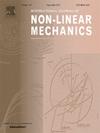Pacemaker position and network topology affect the synchronization patterns in coupled Huber–Braun neurons
IF 2.8
3区 工程技术
Q2 MECHANICS
International Journal of Non-Linear Mechanics
Pub Date : 2025-06-07
DOI:10.1016/j.ijnonlinmec.2025.105173
引用次数: 0
Abstract
Neural synchronization is a fundamental process underlying brain function. However, the interplay between the neuron’s position in the network and its impact on synchronization is not fully understood. This paper examines the impact of a pacemaker on neural synchronization and their firing patterns using the Huber–Braun model. This examination is carried out through numerical analysis, utilizing established metrics such as Inter-Spike Interval (ISI) bifurcation and the order parameter, R. Our observations indicate that within small-scale networks, varying structural arrangements—namely, linear chains, rectangular configurations, and regular network models—can elicit diverse collective behaviors. These include the emergence of chimera states, anomalous synchronization patterns, and cluster synchronization phenomena. We further applied an Eigenvector-based method to analyze and verify cluster synchronization in specific cases. Additionally, we present evidence that links quasi-Laplacian centrality to the threshold of coupling strength required for synchronization in these networks.
起搏器位置和网络拓扑结构影响耦合Huber-Braun神经元的同步模式
神经同步是大脑功能的基本过程。然而,神经元在网络中的位置及其对同步的影响之间的相互作用尚未完全了解。本文使用Huber-Braun模型研究了起搏器对神经同步及其放电模式的影响。该研究通过数值分析进行,利用诸如尖峰间隔(ISI)分岔和顺序参数r等已建立的指标。我们的观察表明,在小规模网络中,不同的结构安排——即线性链、矩形配置和规则网络模型——可以引发不同的集体行为。这些包括嵌合体状态、异常同步模式和集群同步现象的出现。我们进一步应用了基于特征向量的方法来分析和验证特定情况下的集群同步。此外,我们提供的证据表明,准拉普拉斯中心性与这些网络中同步所需的耦合强度阈值有关。
本文章由计算机程序翻译,如有差异,请以英文原文为准。
求助全文
约1分钟内获得全文
求助全文
来源期刊
CiteScore
5.50
自引率
9.40%
发文量
192
审稿时长
67 days
期刊介绍:
The International Journal of Non-Linear Mechanics provides a specific medium for dissemination of high-quality research results in the various areas of theoretical, applied, and experimental mechanics of solids, fluids, structures, and systems where the phenomena are inherently non-linear.
The journal brings together original results in non-linear problems in elasticity, plasticity, dynamics, vibrations, wave-propagation, rheology, fluid-structure interaction systems, stability, biomechanics, micro- and nano-structures, materials, metamaterials, and in other diverse areas.
Papers may be analytical, computational or experimental in nature. Treatments of non-linear differential equations wherein solutions and properties of solutions are emphasized but physical aspects are not adequately relevant, will not be considered for possible publication. Both deterministic and stochastic approaches are fostered. Contributions pertaining to both established and emerging fields are encouraged.

 求助内容:
求助内容: 应助结果提醒方式:
应助结果提醒方式:


